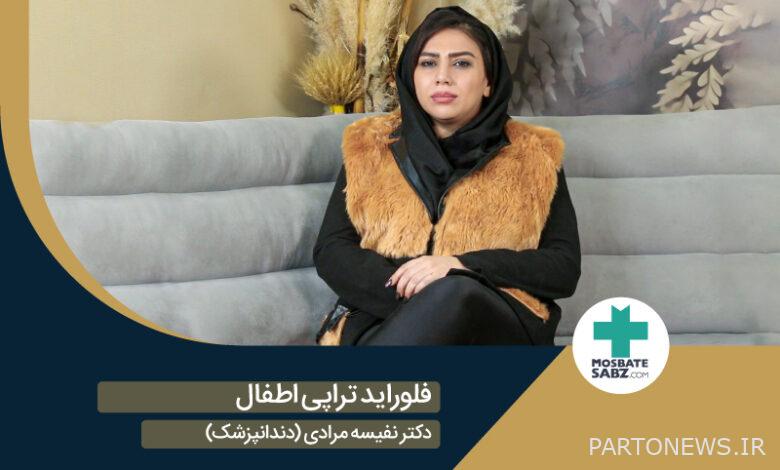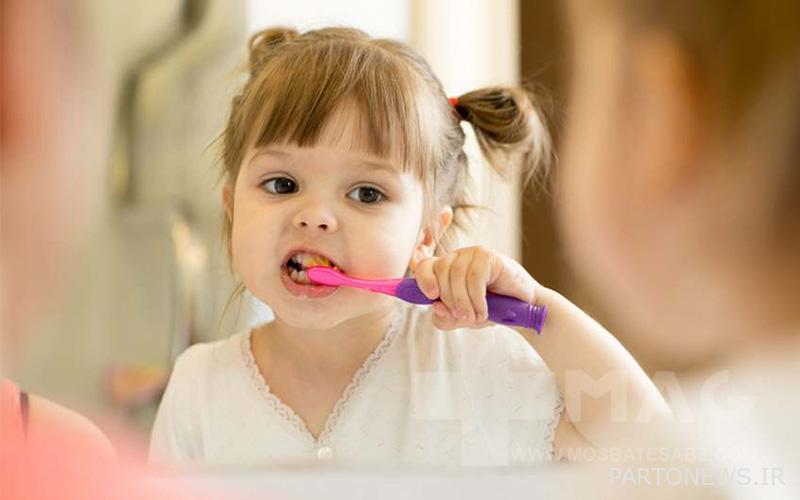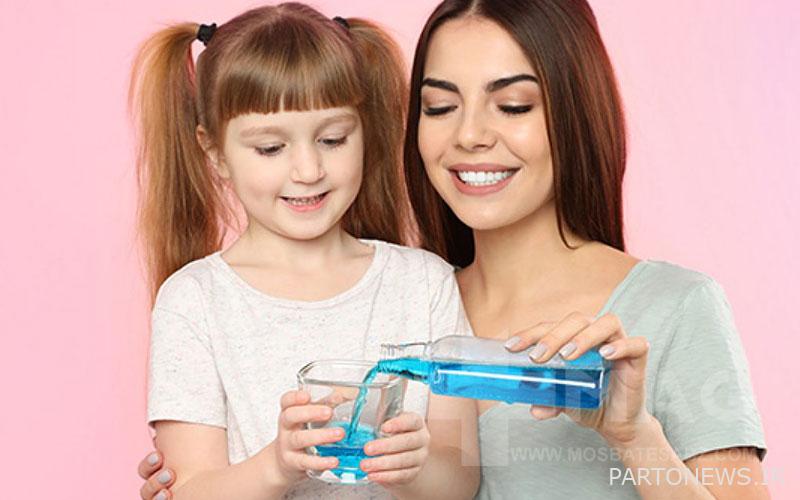All about pediatric fluoride therapy

When the first teeth grow in their child’s mouth, parents think of getting a toothbrush for him to ensure the health of his teeth. As the child grows older, he should be taught how to use dental floss to prevent the decay of milk teeth. But another solution that parents probably pay less attention to is fluoride therapy for children. Many dentists recommend fluoride therapy for children so that the child’s teeth are healthy and free of decay.
What we read in this article
What is fluoride therapy?
Fluoride is a naturally occurring mineral found in water, many foods, in the earth’s crust, and widely in nature. Fluoride is usually added to drinking water or toothpaste to strengthen teeth and prevent them from decaying. Fluoride helps the health of tooth enamel and protects teeth from bacteria that cause tooth decay.
Why is fluoride therapy recommended for children?
Researchers in the 1930s concluded that people who always used fluoridated drinking water had 66% less tooth decay than others. After that, other research repeatedly showed that drinking water containing fluoride greatly reduces the level of tooth decay.
Children’s fluoride therapy helps to protect the child’s milk teeth from the acids in the mouth and prevent the signs of tooth decay. Harmful acids in the mouth are formed by bacteria combined with sugar. Acid damages tooth enamel. Tooth enamel is the outer protective layer of the tooth, which is very hard and rigid.
Every day, minerals are lost and added to the enamel layer through natural processes called demineralization and remineralization. When acid attacks tooth enamel, minerals are lost, and other minerals such as phosphate, calcium, and fluoride are added back when children drink water. Caries occurs when excessive demineralization occurs without sufficient mineralization to restore tooth enamel.
Benefits of fluoride therapy for children
Fluoride therapy or children’s fluoride therapy helps to reduce tooth decay and is usually recommended from 3 years of age onwards. The use of fluoride in dentistry ensures that your child’s teeth have received enough fluoride to resist the acid breakdown of the enamel layer.
In order for the benefits of fluoride therapy to reach children’s teeth, a small amount of fluoride is needed. Fluoride therapy for children is applied to the teeth in the form of gel, foam or varnish. In fluoride therapy, the amount of fluoride used is more than the amount of fluoride in drinking water or toothpaste. Research shows that fluoride therapy for children is as effective in reducing the risk of early tooth decay as it is in strengthening growing teeth.
So, once again, the benefits of fluoride therapy for children can be listed as follows:
- Strengthen tooth enamel
- Protecting teeth from harmful bacteria in the mouth
- Slow down the process of tooth decay
- Reducing the possibility of toothache, tooth decay and gum infection
In addition to fluoride therapy, buying a suitable toothbrush and dental floss should not be forgotten to maintain the health of the teeth.
Effects of fluoride for children
According to the Association of Dentists, it can be said that drinking water containing fluoride is completely safe for children and is an important factor in maintaining the health of teeth. The use of fluoride from 6 months to 16 years of age is especially important for the development of children’s teeth because the growth of all milk and permanent teeth occurs during this period. Of course, be careful that fluoride treatment is also recommended for adults.
With these interpretations, you may ask what are the effects of fluoride for children? Is fluoride therapy for children completely safe? As a warning, we must tell you that fluoride can be dangerous in very high doses. The upper dose is different for each person and actually depends on the weight of the child or adult. As a parent of a child, you should not worry about the fluoride in the water, but the use of fluoride products such as toothpaste or mouthwash should be monitored so that they are not used excessively.
Especially if your child is under 6 years old, you should keep fluoride products out of his reach. If you use toothpaste containing fluoride for your child, be careful that only a pea-sized amount of toothpaste should be used on the toothbrush; no more. The side effects of fluoride overdose for children are summarized in the following cases:
Change in tooth color or change in the appearance of tooth enamel
The change in the appearance of tooth enamel is called fluorosis. Fluorosis is a condition in which white streaks appear on the surface of the teeth. Fluorosis is caused by excessive consumption of fluoride and damages tooth enamel. Also, if fluoride is used in excess, the color of the teeth may change and the teeth may become discolored. If your child is not yet able to completely discard the toothpaste, do not use toothpaste containing fluoride.
Fluoride poisoning in the body due to excessive use
Is fluoride therapy harmful? This is not very common, but in general, consuming fluoride in high amounts can be toxic. For children under 6 years, fluoride varnish is often used in fluoride therapy. If the fluoride is in the form of a foam or gel, it may be swallowed by the child, causing nausea and vomiting and other risks.
At what age should a child use fluoride toothpaste?
Dentists recommend that a very small amount of fluoride toothpaste be used from the time the first baby teeth appear in the child’s mouth until the child reaches the age of 3. After 3 years of age, you can put a pea-sized amount of fluoride toothpaste on the toothbrush and brush your teeth. However, be sure to consult a pediatric dentist in this regard. He may not recommend toothpaste containing fluoride for your child, especially if he does not know how to throw the toothpaste out of his mouth.

Fluoride therapy for children under two years of age
Fluoride therapy for children under 2 years of age should be done under the supervision of a pediatric dentist and with fluoride varnish. The use of fluoride varnish greatly minimizes the risk of swallowing fluoride by the child. Fluoride varnish adheres to teeth and reduces the risk of tooth decay by protecting tooth enamel. For children under 2 years of age, other fluoride therapy methods should not be used because there is a risk of swallowing fluoride. In general, as we have already mentioned, it is better to give fluoride therapy to children from the age of 3 onwards.
How to apply fluoride to children’s teeth at home
Children’s fluoride therapy can be implemented at home. You can use one of the following methods:
Fluoride therapy of children’s teeth with the help of toothpaste
Use toothpaste containing fluoride for your child and increase the time of brushing to get a better result to prevent tooth decay.
Child fluoride treatment with mouthwash at home
Use fluoride mouthwashes for your children. Of course, the child must be of an age to be able not to swallow the mouthwash. Using mouthwash helps to maintain the health of teeth and gums.

Fluoride treatment with varnish at home
At home, you should usually use gel for tooth varnish. Follow the instructions below:
- First, the child should brush his teeth well.
- You should wait until the teeth are dry after brushing.
- Apply a special gel on the surface of the teeth with a brush and wait until they dry.
- It is better for the child not to eat anything for 2 to 5 hours and after that the mouth and teeth should be washed.
However, consult a dentist about how long the varnish will remain on the child’s teeth.
What should be done after children’s fluoride therapy?
After fluoride therapy, children should pay attention to the following points so that fluoride therapy has its best effect on the teeth:
- About 2 to 4 hours after fluoride treatment, the child should not eat anything.
- The child should not drink anything until half an hour later.
- After fluoride treatment, the child’s mouth should be rinsed.
- For two days after fluoride treatment, it is better to use foods such as soup and mashed potatoes.
- Eating very cold or very hot foods should be avoided.
- Foods that stick to the teeth, spicy and crunchy should not be eaten.
- Citrus fruits should be avoided.
- Sweet drinks should not be consumed.
- On the day of children’s fluoride therapy, it is better for the child not to brush their teeth.
A final word on children’s fluoride therapy
Children’s fluoride therapy should be done under the supervision of a dentist. However, you can easily prevent tooth decay in yourself or your children at home by using mouthwash or toothpaste containing fluoride. The general recommendation is to go to the dentist for a visit every 6 months so that if signs of tooth decay are observed, it can be prevented from progressing sooner. Thank you for being with us in this article from Positive Green Online Pharmacy magazine.

